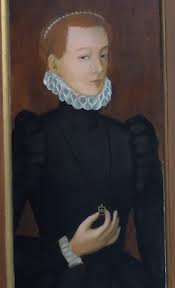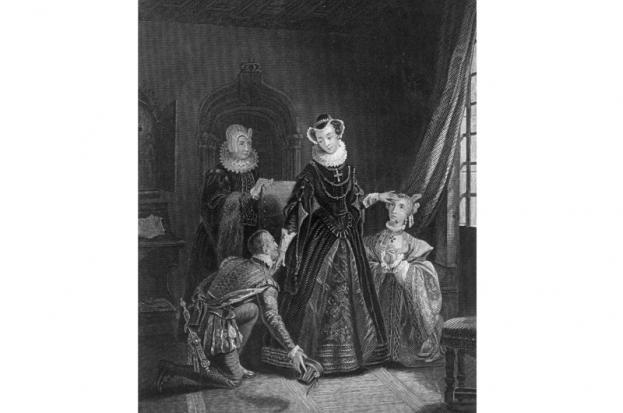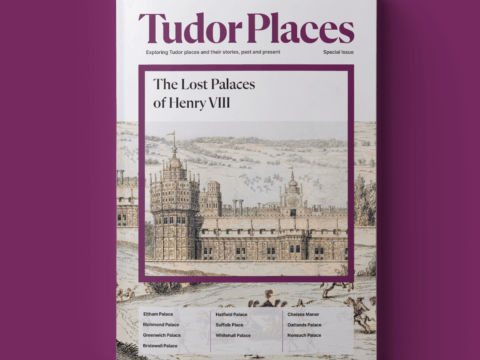The Four Marys
Companions to Mary, Queen of Scots
Chapter 4 : The Marys in Love
Whatever the Marys’ earlier matrimonial intentions, the first of them, Livingston, was married in March 1565 to John Sempill, son of Robert, Lord Sempill. Knox, who had referred to Livingston as “lusty”, suggested the match was rushed – Livingston and Sempill, who was a noted dancer, had been tripping the light fantastic with gusto and from this, Knox inferred that she was pregnant. It seems unlikely, as the betrothal took place a year before the wedding and the first of their several children was not born until a year after it.
The Queen attended the elaborate ceremony, and gave them a gift of a bed hung with scarlet and black velvet, with embroidered taffeta curtains and silk fringes, as well as land, drawing Knox’s fire again for granting lands to courtiers. Livingston remained at court as Keeper of the Queen’s Jewels. When Mary made a will in 1566, Livingston drew up a minute inventory of her jewels - specimens of which were bequeathed to the Marys, should the Queen die in childbed.
Beaton, considered the best-looking of the four, caught the eye of Thomas Randolph, the English Ambassador. Around twice her age, perhaps he hoped that his position would attract her. The Queen’s biographer, John Guy, refers to them as lovers, but it seems unlikely that one of the Queen's closest friends would expose Mary to the risks of confidential information leaking out - unless Beaton were acting in concert with Mary, extracting information from Randolph.
Beaton must have had the reputation of being politically influential with the Queen, as she received letters and gifts from the wife of Sir Nicholas Throckmorton, one of the other English Ambassadors. Beaton was courted by Randolph for some time, but in 1566 married Alexander Ogilvy, by whom she had at least one son. Beaton died in around 1598 and her widower promptly married Lady Jean Gordon, the wife whom James Hepburn, Earl of Bothwell, had thrown off to marry Queen Mary.
Livingston was full of spirits and Beaton was the prettiest, but Fleming apparently carried the palm for overall attractiveness. As “Queen of the Bean” at the Twelfth Night ceremonies in 1564 she was dressed in cloth of silver and jewels, and this “flower of the flock’s” dazzling looks attracted poetry and prose panegyrics.
Fleming was courted in 1564 by William Maitland of Lethington. Maitland had a chequered history in Mary’s service. One of the few nobles who was Protestant by conviction, he had joined the Lords of the Congregation and was a friend of Sir William Cecil, the English Secretary of State, whose whole life was dedicated to eliminating Mary. Maitland failed to warn Mary of the plot to murder her secretary, David Rizzio and it is likely, too, that he knew of the plot against Darnley.
Fleming, of course, probably had no idea of the extent of Maitland’s duplicity. Maitland seems to have fallen headlong in love with her, and his passion was the subject of some mockery at court – nearly twenty years older than she was, he was described by one courtier as being as “suitable for her as I am to be Pope.”
Maitland has been identified as a prime suspect for the forger of the Casket Letters, on which suspect documents the accusations against Mary of Darnley’s murder are based. Whatever his machinations, he later became an adherent of what was known as the Queen's Party, that wished to restore her, if not to full monarchy, at least to regency for her son James. The Queen’s Party, including Fleming and Maitland, held Edinburgh Castle in 1573, but when it was captured by the English, they were handed over to the Regent, Morton.
Fleming was freed, struggling to retain her diamond and ruby chain that had been Queen Mary’s, whilst Maitland, carried out of the castle on a litter, died before he could be brought to trial. Suicide was rumoured. The King's Party planned to hang, draw and quarter his dead body but Fleming wrote to Cecil, asking him to intervene. He passed the plea to Elizabeth who requested the Scottish lords to spare the body.

Fleming waited until 1583 for Maitland’s lands to be restored. She and Maitland had two children - a son, James, converted to the old faith and fled to France, while their daughter, Margaret, became Countess of Roxburghe.
Seton never married, but stayed with her mistress for many years. After the surrender at Carberry Hill, she joined Mary in captivity at Lochleven Castle. By standing at a window, dressed in the Queen's clothes, she gave Mary time to slip out of the castle, and escape across the loch in a rowing boat. Later, when Mary fled to even more onerous imprisonment in England, Seton was permitted to join her, and spent fifteen years incarcerated in the gloomy series of castles where Mary wore her life away.

In 1570 Seton's mother wrote to her, and was apprehended by the King's Party who sought to banish her from Scotland, for communicating with Mary's household. Elizabeth intervened, requesting forbearance “if the cause be no greater” than writing to her daughter. By 1583, even Seton's devotion and health were tried by the long imprisonment and she was given leave to retire to a French convent at Rheims. Seton lived on to see her mistress' son inherit the crown of England, dying in 1615, and being buried in the convent she had dwelt in for over thirty years.
Were her last thoughts of the charismatic Queen she had served so faithfully or did it all seem a distant dream?
But why should I fear a nameless grave
When I've hopes for eternity….
There was Mary Seton and Mary Beaton,
And Mary [Fleming] and me
This article was first published on 21 April 2015 on the BBC History website
